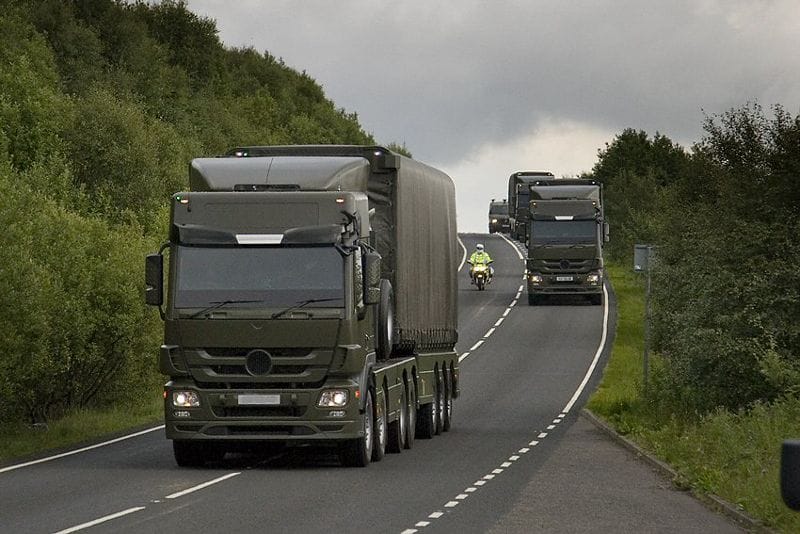Safety problems plaguing the nuclear bomb convoys that regularly crisscross the country by road have risen to a record high, according to new figures from the Ministry of Defence (MoD).
The number of convoy incidents logged by officials in 2017 was 44, by far the most since 2008. It brings the total number of recorded incidents in the last ten years to 179.
Critics say the risks are “wholly unacceptable” and it’s only a matter of time before there’s a horrific accident. “The rise in the number of incidents is deeply concerning,” said a spokesperson for the Scottish Government.
“The Scottish Government expects any such transportation to be carried out safely and securely and has made this expectation clear to the UK government.”
The MoD, however, insists that the mishaps were mostly minor and posed no risk to the public. But it has not released details of what happened in each case.
Detailed MoD logs obtained via freedom of information law have shown that previous convoy incidents included collisions, breakdowns and equipment failures.
In the past brakes have failed, fuel has leaked and engines have overheated. Convoys have also got lost and been delayed or diverted by bad weather, accidents and protests.
Convoys comprising up to 20 or more military vehicles transport Trident nuclear warheads at least six times a year between the Royal Naval Armaments Depot at Coulport on Loch Long near Glasgow and the bomb factory at Burghfield in Berkshire. The warheads have to be regularly maintained at Burghfield.
Though they are meant to be secret, the convoys are often photographed, filmed and followed on social media. They travel close to major centres of population such as Glasgow, Edinburgh, Newcastle, Manchester and Birmingham.
According to Nukewatch, which monitors the convoys, three have travelled to Scotland so far this year, including four nuclear warhead carriers and their escort vehicles on 16-17 May via the M74 and the M8. There are also transports of nuclear weapons materials in England.
travelling North to Scotland – Nuclear warhead convoy passes Oxford #scotref https://t.co/jUSzZ1gaFZ
— Annie Smith (@ochaye6dot5) May 16, 2018
The latest incident figures were disclosed by the defence minister, Guto Bebb, in answer to a question from the SNP MP Deidre Brock. “The most deadly weapons that the world has ever known are driven past the homes of millions of Scots and it only needs one accident to create a horror that could never be repaired,” said Brock.
“Even fans of these unspeakable weapons must stop and ask themselves whether the risk to Scotland’s people is worth it. It’s time to stop this utterly reckless practice, time to put the people first, stop the convoys and get rid of nuclear weapons.”
Nuclear convoy incidents
| Year | Number of incidents |
|---|---|
| 2008 | 11 |
| 2009 | 6 |
| 2010 | 14 |
| 2011 | 12 |
| 2012 | 22 |
| 2013 | 10 |
| 2014 | 12 |
| 2015 | 10 |
| 2016 | 38 |
| 2017 | 44 |
| Total | 179 |
Annabelle Ewing, the Scottish Government’s minister for community safety, told the Scottish Parliament on 2 May that she would ask the police and fire services in Scotland “to consider conducting a joint review” of the safety arrangements for convoys.
But Green MSP Ross Greer called on Scottish ministers to lead an urgent review of the convoys and make the findings public. “Councils have not assessed the impact of an accident involving these convoys,” he said.
“It will only be a matter of time before there’s a serious incident involving a nuclear weapon in Scotland.”
David Mackenzie from Nukewatch argued that transporting toxic radioactive materials in the same package as high explosives was a major danger. “The risks involved in the transport of nuclear weapons and weapon materials are wholly unacceptable,” he said.
“As the new UN Treaty on the Prohibition of Nuclear Weapons makes clear, these weapons have appalling humanitarian consequences at all stages of their deployment and use, including when in transit.”
The MoD maintained that defence nuclear materials were transported only when necessary and were subject to strict safety regulations. “In over 50 years of transporting this material, an incident has never posed a radiation hazard to either the public or the environment,” said an MoD spokeswoman.
“The number of transport operations varies from year to year, and these figures in no way indicate unreliability or a lack of maintenance. A convoy could consist of over 20 vehicles, and we record every incident, regardless of how minor.”
She argued that the chance of an incident during transport leading to a radiological hazard was extremely low. “It remains MoD policy not to confirm the presence of nuclear weapons at any particular place or time,” she added.
Photo thanks to Nukewatch.














